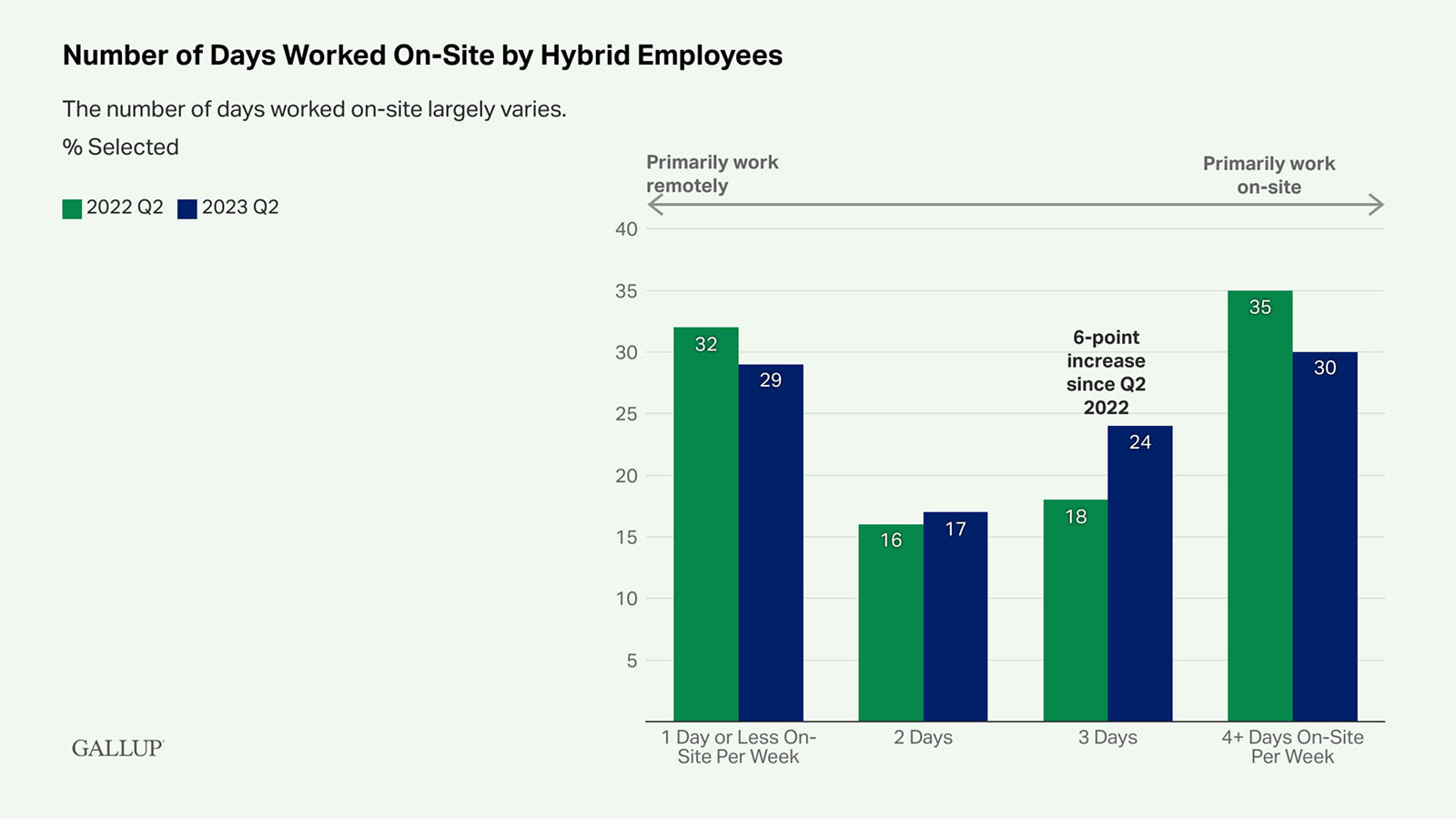Hybrid work is rapidly becoming the new normal in the modern workplace. A recent Gallup survey found that 53% of employees expect to work in a hybrid arrangement, while 24% expect to work from home full-time. As many companies embrace the future of work and adopt "work from anywhere" policies, equipping employees with the right hybrid work instruments is essential for maintaining productivity and enabling seamless collaboration.

In this article, we will explore 15 must-have solutions for navigating the hybrid workplace and achieving success in a distributed work environment. Whether you are a seasoned remote worker or new to the hybrid model, these solutions will help you stay on top of your game.
Takeaways:
- Technology is the backbone of successful hybrid work environments, directly impacting employee engagement and retention
- Integration capabilities are critical — fragmented tools create friction and reduce productivity
- Security considerations become more complex in hybrid settings and require specialized solutions
- Workspace management tools provide critical data for optimizing office space and enhancing collaboration
- The most effective technology implementations involve employee input throughout the selection process
- Regular assessment and adjustment of your tech stack ensures continued alignment with evolving needs
15 Remote Working Tools You Need for a Hybrid Workplace
Project Management Tools for Hybrid Teams
| TOOL | KEY FEATURES | BEST FOR |
| Asana | Task organization, automation, app integrations | Teams needing clear task assignments |
| Trello | Visual boards, drag-and-drop, easy tracking | Teams that prefer a visual workflow |
| Monday.com | Multiple views (charts, calendars, tables), customization, reporting | Teams needing flexibility and insights |
In a flexible work environment, effective project management software keeps teams aligned by streamlining workflows, improving collaboration, and tracking progress regardless of location. Here are three top solutions designed to optimize hybrid work.
Asana
Asana is one of the top tools that help teams organize tasks clearly, making it easy to see who’s working on what. It also automates repetitive tasks, saving workers time for important things. Plus, Asana connects easily with many other apps.
Trello
Trello shows tasks visually using boards and cards, making it perfect for seeing project progress at a glance. Its simple and intuitive design allows teams to quickly move tasks around, track deadlines, and share updates effortlessly.
Monday.com
Monday.com offers many ways to view project progress, including charts, calendars, and tables. It allows users to easily change and adapt to different projects, providing clear reports on progress and time spent.
Hybrid Office & Workspace Optimization Software
As organizations adapt to fluctuating office attendance patterns, managing office space becomes a critical challenge. Smart space utilization tools provide the data-driven insights needed to transform traditional workplaces into dynamic environments that cater to collaboration needs while eliminating wasted resources. These platforms help facility managers understand precisely how space is being used and allow employees to confidently plan their in-office days.
Avigilon Alta Access
It is a cloud-native access control system designed for ultimate security and flexibility. It enables fully remote, serverless management from any device, ensuring 24/7 access control visibility. With patented Triple Unlock technology, it supports key cards, fobs, PINs, and mobile credentials for secure, reliable entry. Automatic updates, real-time alerts, and an open platform provide future-proof protection against evolving security threats. Avigilon simplifies building access management with intuitive software, remote unlock capabilities, and comprehensive credential support, making it easier to control multiple users and sites from anywhere.
UnSpot
UnSpot specializes in coordinating meeting rooms and collaborative areas, enabling teams to book spaces equipped with the technology they need, such as whiteboards or video conferencing equipment. The platform's analytics show space utilization and amenity demand, helping companies optimize their layout.
Case Study: Optimizing Hybrid Workspaces with UnSpot
Transitioning to a hybrid work model made office space management challenging. Many companies faced underutilized areas, high rental costs, and inefficient booking systems. Without a structured solution, companies wasted resources on unused spaces, while employees struggled with workspace reservations. Mismanaged meeting rooms led to scheduling conflicts and reduced productivity.
UnSpot streamlined the transition, optimizing space and reducing costs. Discovery Channel cut office expenses and improved booking convenience. Rocket 10 enhanced office efficiency with a flexible meeting room reservation system, ensuring better space utilization.
Communication Tools to Enhance Collaboration
| TOOL | KEY FEATURES | BEST FOR |
| Slack | Channel-based messaging, app integrations, searchable history | Daily team communications and quick updates |
| Microsoft Teams | Video meetings, Office 365 integration, file collaboration | Organizations heavily invested in Microsoft ecosystem |
| Zoom | High-quality video, breakout rooms, webinar capabilities | Virtual meetings, team events, and large gatherings |
In the hybrid work model, communication tools serve as the digital bridge connecting on-site and remote team members. These platforms eliminate distance barriers and create a unified workspace where ideas flow freely regardless of physical location. Leveraging the right remote working tool unlocks the full potential of hybrid work by creating a virtual environment that mimics the spontaneity and connectivity of face-to-face interaction.
Slack
Slack has revolutionized hybrid team coordination with its channel-based structure, enabling organized conversations by department, project, or interest. With real-time messaging, file sharing, and integrations with platforms like Google Workspace and Asana, Slack helps in-office and remote employees stay connected and maintain workflow continuity.
Microsoft Teams
This tool stands out as a comprehensive solution by seamlessly combining video conferencing, chat, calls, and robust collaboration features. Its tight integration with the Microsoft 365 ecosystem enables document co-authoring, shared calendars, and task management within a single platform, eliminating the need to switch between apps.
Zoom
Zoom is one of the go-to video conferencing tools for virtual meetings, thanks to its reliable HD video quality and user-friendly interface. The breakout rooms feature makes team workshops and training sessions more effective, while its real-time collaborative whiteboard feature encourages creative problem-solving during team meetings.
File Sharing & Document Collaboration Software
Effective hybrid workplace technology must include best remote working tools for document sharing and co-creation. As teams split their time between home and office, cloud-based file-sharing solutions eliminate the friction of exchanging information and enable real-time collaboration, allowing employees working remotely to stay connected and get their work done seamlessly. These platforms serve as the digital foundation upon which distributed teams build their collective knowledge and work products.
Google Workspace
Google Workspace offers an intuitive suite of collaborative apps like Docs, Sheets, and Drive, enabling instantaneous real-time collaboration without the need to email attachments, all made easily accessible through its cloud-based platform.
Notion
Notion provides a flexible all-in-one platform that combines notes, wikis, and project management, allowing teams to build customized, evolving knowledge bases, which is particularly valuable for documenting processes in hybrid environments.
Dropbox
Dropbox delivers enterprise-grade cloud storage with robust sharing controls, featuring version history for tracking document changes and recovering previous versions, while its offline capabilities ensure continued efficiency even without internet access.
✓ Essential File-Sharing Tools Checklist:
- Collaborative editing capabilities
- Intuitive interface for minimal training
- Cross-platform accessibility (mobile, desktop)
- Strong permission controls
- Version history tracking
- Search functionality
- Integration with other workplace tools
- Enterprise-grade security features
Productivity & Time Management Tools
The shift to remote work environments has made visibility into time allocation and output challenging for both managers and employees. Productivity tools designed for distributed teams help bridge this gap by providing data-driven insights that optimize workflows, eliminate time-wasting activities, and maintain accountability across distributed teams. These solutions transform subjective impressions of work patterns into concrete metrics that can inform both individual and organizational improvements.
Clockify
Clockify stands out as an essential time-tracking solution for distributed teams who need to monitor billable hours, project progress, and resource allocation. Its user-friendly interface lets employees switch tasks with one click. Robust reporting helps managers find bottlenecks and optimize workflows.
RescueTime
RescueTime takes performance analysis to a new level with AI-powered insights that automatically categorize activities and identify focus patterns. The platform tracks peak productivity and suggests optimal schedules. It also reduces distractions with focus mode and gentle reminders.
Security & Cloud-Based Access Solutions
| SECURITY RISK | IMPACT | SOLUTION |
| Unsecured home Wi-Fi | Data interception, network infiltration | VPN encryption (NordVPN) |
| Password vulnerabilities | Account breaches, unauthorized access | Password manager (LastPass) |
| Phishing attacks | Credential theft, malware installation | Security awareness training + MFA |
| Unpatched personal devices | System vulnerabilities, data leakage | Endpoint security management |
| Public Wi-Fi exposure | Traffic monitoring, session hijacking | VPN mandatory policy |
In a distributed work model, security vulnerabilities multiply as employees connect through various networks and devices. The traditional security perimeter has dissolved, with sensitive company data traveling between office networks, home Wi-Fi, and public hotspots. Organizations must centralize their security approach to provide consistent protection regardless of an employee's location while maintaining seamless access to necessary resources.
LastPass
LastPass offers an enterprise-grade password management solution that eliminates risky practices like reusing credentials or storing them in spreadsheets. It stores all company passwords in a secure vault for safe sharing. Multi-factor authentication verifies identity before granting access.
NordVPN Teams
NordVPN Teams creates encrypted tunnels for remote workers' internet traffic, protecting data even on unsecured networks. This enterprise VPN provides in-office-level security anywhere. It prevents data interception and enables seamless access to location-restricted resources.
How to Choose the Right Hybrid Work Tools
Key Factors to Consider
Selecting the right hybrid work technology isn't just about following trends — it's a strategic decision that directly impacts employee satisfaction, productivity, and business outcomes. Research by Qualtrics shows that employees supported by effective hybrid workplace tech are 230% more engaged and 85% more likely to remain with their organization. The right tools should seamlessly integrate with your existing systems while offering features like intuitive interfaces that require minimal training.

Blindly adopting the latest tech trend rarely works; the challenge lies in finding solutions that match your specific culture and infrastructure. The most successful organizations collaborate with employees to understand their needs before making technology decisions, ensuring chosen solutions are embraced rather than merely tolerated.
✓ Tool Selection Checklist:
- Compatibility with existing systems
- User-friendly interface requiring minimal training
- Strong security features and compliance capabilities
- Scalability to accommodate growth
- Mobile accessibility for on-the-go productivity
- Robust customer support and implementation assistance
- Cost-effectiveness relative to expected benefits
- Positive reviews from similar organizations
Comparing Free vs. Paid Remote Work Tools
| FEATURE | FREE TOOLS | PAID SOLUTIONS |
| Storage capacity | Limited (typically 5-15GB) | Expanded (100GB+ per user) |
| User administration | Basic or nonexistent | Centralized management console |
| Security features | Standard encryption | Advanced controls and compliance tools |
| Support options | Community forums, basic documentation | Dedicated account manager, priority support |
| Integration capabilities | Limited number of connections | Comprehensive API access and native integrations |
| Customization | Minimal | Extensive branding and workflow customization |
| Analytics | Basic usage statistics | Comprehensive reporting and insights |
While free collaboration platforms can be tempting for organizations looking to minimize costs, they often come with limitations that can impact productivity in hybrid environments. Many tools like Google Workspace or Slack offer basic versions that provide fundamental features, but they typically restrict storage capacity, limit the number of integrations, and cap participant counts for video calls. These constraints might seem manageable initially but can quickly become problematic as your hybrid team grows or your collaboration needs become more complex.
Premium solutions offer enhanced security, dedicated support, and advanced features, significantly improving collaboration for remote teams. For example, upgrading from basic Zoom removes the 40-minute meeting limit and adds transcription, enhancing accessibility. Similarly, paid project management tools typically offer automation, advanced reporting, and better integration.
Conclusion & Key Takeaways
The modern hybrid workplace has evolved beyond a temporary solution into a permanent fixture of our professional landscape. As this transformation continues, technology serves as the critical infrastructure connecting distributed teams and enabling seamless collaboration across locations. The right hybrid work solutions don't just bridge physical gaps — they allow people to work more flexibly and efficiently. These solutions also offer streamlined communication and foster connections in ways that weren’t possible in traditional office-only environments.
Optimize your hybrid work strategy by aligning technology with employee needs, prioritizing seamless integrations, and addressing workflow pain points. Successful implementation requires thoughtful change management, training, and ongoing feedback. Remember, technology alone won't suffice — it must be supported by clear policies and leadership practices that reinforce company culture across locations.







